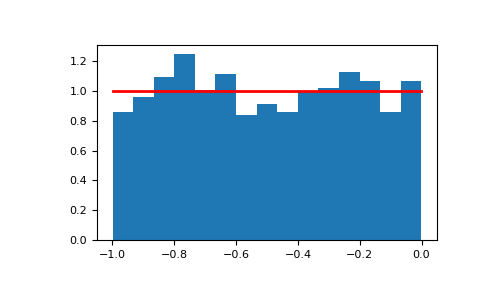numpy.random.Generator.uniform¶
method
-
Generator.uniform(low=0.0, high=1.0, size=None)¶ Draw samples from a uniform distribution.
Samples are uniformly distributed over the half-open interval
[low, high)(includes low, but excludes high). In other words, any value within the given interval is equally likely to be drawn byuniform.- Parameters
- low
floator array_like of floats, optional Lower boundary of the output interval. All values generated will be greater than or equal to low. The default value is 0.
- high
floator array_like of floats Upper boundary of the output interval. All values generated will be less than high. The default value is 1.0.
- size
intortupleof ints, optional Output shape. If the given shape is, e.g.,
(m, n, k), thenm * n * ksamples are drawn. If size isNone(default), a single value is returned iflowandhighare both scalars. Otherwise,np.broadcast(low, high).sizesamples are drawn.
- low
- Returns
- out
ndarrayor scalar Drawn samples from the parameterized uniform distribution.
- out
See also
Notes
The probability density function of the uniform distribution is
anywhere within the interval
[a, b), and zero elsewhere.When
high==low, values oflowwill be returned. Ifhigh<low, the results are officially undefined and may eventually raise an error, i.e. do not rely on this function to behave when passed arguments satisfying that inequality condition.Examples
Draw samples from the distribution:
>>> s = np.random.default_rng().uniform(-1,0,1000)
All values are within the given interval:
>>> np.all(s >= -1) True >>> np.all(s < 0) True
Display the histogram of the samples, along with the probability density function:
>>> import matplotlib.pyplot as plt >>> count, bins, ignored = plt.hist(s, 15, density=True) >>> plt.plot(bins, np.ones_like(bins), linewidth=2, color='r') >>> plt.show()
